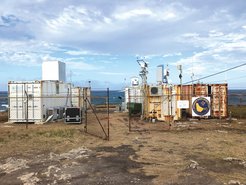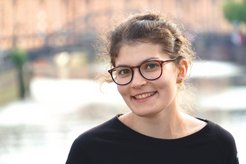Cloud watching at its best
From cold and wet Hamburg to tropically hot Barbados: Where others go on holiday, meteorologist Theresa Lang was part of the international EUREC4A project. Together with researchers from the MPI for Meteorology and from all over the world, she took a close look at the clouds.

Getting off the plane in Bridgetown on January 20 almost knocked me sideways. The combination of extreme heat and high humidity was too much of a contrast to the cold, wet weather in Hamburg that I had left behind me just a few hours before. However, within two days I’d become accustomed to the tropical temperatures – which was just as well, because the weather barely changed at all over the two weeks that followed.
The weather was also the subject of our research. I was taking part in EUREC4A, an international project which is investigating how clouds react to climate change and how these changes will affect climate development in the long term. We were specifically interested in low-level clouds, i.e. clouds at an altitude of two kilometers, which are typical of regions like Barbados that lie within the trade wind belts. These clouds act as particularly intensive sunlight reflectors, which means their impact is formidable. That’s why we are interested in finding out how climate change affects their behavior. We also want to find out why clouds arrange themselves in different ways. These arrangements appear to be completely random: sometimes clouds are scattered across the sky, other times they group together in large clusters. We employed an entire fleet of research ships, aircraft and ground-based measurement stations to shed light on these processes. My initial fear that I might have nothing to do dissipated faster than a storm cloud on a summer day.
There was no shortage of tasks, particularly during the first few days. One of my jobs was to help evaluate the previous day’s measurements in order to generate daily weather summaries. I also found it exciting to prepare the weather balloons that were released into the sky every four hours.

In all, there were around one hundred people working at the project site. Like myself, many of them worked for the Max Planck Institute for Meteorology; we were also joined by researchers from every country under the sun – all in all, a colorful international crowd. The people in charge at EUREC4A also attached great importance to involving the local residents in our research. We worked in close cooperation with the island’s Caribbean Institute for Meteorology and Hydrology to make weather forecasts.
This collaboration ensured that the project was warmly received by the local population besides creating a pleasant working atmosphere. That also meant it wasn’t so bad if we sometimes had to work longer hours or get up at 2:30 a.m. to help prepare a weather balloon. Regular work hours are normally very important to me, but that didn’t matter on Barbados; you always wanted to be in on the action. Especially as I still had the opportunity to lie on the beach and explore the island. People often approached me during my outings and I found the Barbadians very friendly.
I will miss their hospitality – as well as the wonderful weather and the glorious sunsets. However, I don’t feel as nostalgic about the food. It was quite tasty, but eating grilled fish every day does get rather monotonous. Since I worked in a team and lived in shared accommodation, there were always people around and I sometimes missed having time to myself.
But all in all, these two weeks were a once-in-a-lifetime experience that offered countless highlights. One of the best was flying in HALO, the German Aerospace Center’s research aircraft. While the pilot followed a previously defined flight path, my colleagues and I released dropsondes, which then glided to the ground. I’d never have expected to be allowed to go along on a flight in this plane. And even though the flight was relatively short, I will never forget the views from above this idyllic island.













